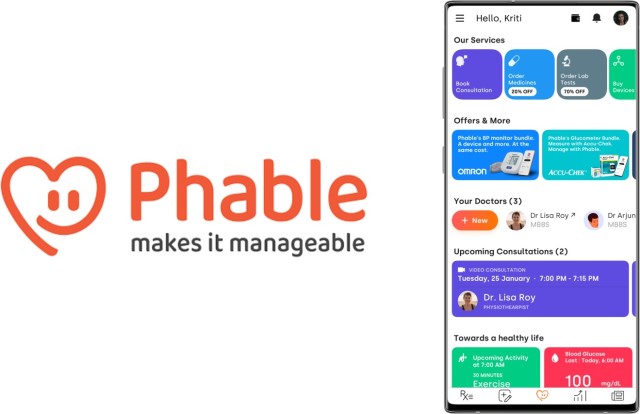PUNE: Phable India’s largest Chronic Disease Management App, unveiled insights from their recent clinical studies conducted for Hypertension and Type 2 Diabetes. The studies were presented at the BPCON Conference 2022 – Annual Meeting of Indian Society of Hypertension, Lucknow, and at the RSSDI Conference 2022 – Annual Meeting of Research Society of the Study of Diabetes in India, Chennai.
The studies established that digital therapeutics (DTx) intervention, applied through Phable’s proprietary algorithm and smartphone devices, helped chronic disease patients regain control of their health.
Chronic diseases such as Type 2 Diabetes and Hypertension are called lifestyle diseases because their risk factors are linked to one’s way of living. The management of these conditions requires regular self-monitoring and behavior change, which seem like the easiest things to do but are difficult to stick to. Health-related behavior change needs consistency and constant nudging to become an implementable reality.
Technology-driven behavior changes powered by Phable’s algorithm and applied through a smartphone can be the constant companion that chronic disease patients need. Using smartphones, wearables, and monitoring devices, patients can self-monitor their health parameters and report them to the Phable app. Phable’s proprietary algorithm takes in the health signals and suggests suitable actions to help drive behavior change and treatment adherence in patients. Chronic disease patients can take control of their health with Phable, which is supported by the expertise of 17,000 doctors and the experience of helping 4.5 million Indians on their health journey.
The advantages of adopting smartphone-enabled monitoring of chronic diseases are numerous and varied. Therefore, it needs to be adopted quickly by patients and doctors alike. Phable’s recent studies go on to establish the effectiveness of DTx in chronic disease management.
Type 2 Diabetes
The study on the role of Digital Therapeutics in the management of Type 2 Diabetes was conducted over a period of 12 weeks in Type 2 Diabetes patients. The DTx intervention included a specifically designed interactive and algorithmic management of diet, physical movement, health education, and self-monitoring via the Phable App.
The study found that patients with Type 2 Diabetes benefited significantly from Phable’s proprietary Diabetes Management program, as seen by a reduction of their HbA1c values (an average of blood glucose levels in the past 3 months) at the end of the 12-week period. Particularly, patients with higher severity of Diabetes saw a significantly greater improvement in blood sugar control. It was also found that patients who had been diagnosed with Type 2 Diabetes within the last 1 year saw much greater benefits from the digital therapeutic intervention.
As per the results, after 12 weeks, patients with HbA1c levels ≥ 8% showed a change in HbA1c of -1.45%. Also, patients with Diabetes of less than 1-year duration showed a change in HbA1c of -1.96%.
These results show that compared to conventional healthcare models, Phable’s DTx-enabled intervention has proved to be more effective in improving blood sugar control through behavior change and self-management of Diabetes in patients.
Hypertension
The study on blood pressure control was conducted over 12 weeks on patients with uncontrolled hypertension (BP ≥140/90 mmHg) under stable treatment. The interventions under DTx included proprietary algorithmic management of hypertension through – dietary modification, stress management, physical activity, patient education, and self-monitoring.
The results showed that the mean blood pressure of the patients reduced by 28/19 mmHg from a baseline reading of 155/100 mmHg to 127/82 mmHg. Amongst the patients, 82.4 % achieved the European Society of Cardiology (ESC) and Indian Council of Medical Research (ICMR) recommended goal of systolic blood pressure <140 mmHg. Also, 67.6% of patients returned to controlled blood pressure levels of <140/90 mmHg and 35.2% achieved the optimum blood pressure reading of <130/80 mmHg. Notably, as the severity of hypertension increased, the benefit in terms of reduction in blood pressure also increased.
These results clearly establish the effectiveness of Phable’s DTx intervention in improving the blood pressure values of patients through behavior modification and self-management of hypertension.
Speaking on the results from the clinical studies, Dr. Suhas Patil, Health Strategy Lead, Phable, stated, “The studies were conducted to irrefutably demonstrate that a smartphone – an everyday device, can help monitor as well as manage chronic diseases, through precision in therapy and personalization of treatment. DTx, which makes use of mobile applications and analytics, can help achieve the remission of chronic diseases. A sustained DTx intervention, over time, will help patients lower their dependency on medicines. These studies bring out the importance and urgency of DTx adoption to lead healthier lives.”
Abstracts of the Research Papers:
Type 2 Diabetes
To evaluate the effectiveness of DTx intervention with respect to the severity and duration of Type 2 Diabetes, a pre-and post-intervention study was conducted over 12 weeks. Type 2 Diabetes patients in the age group of 18-65 years on stable antidiabetic medication and HbA1c ≥ 6.5% were enrolled in the study. DTx intervention was provided by healthcare experts via the Phable App. The mean age of patients was 48 years, with 55% male and 45% female patients.
Result:
The study found that patients with higher severity of Type 2 Diabetes saw a significantly greater improvement in blood sugar control. Also, patients who had been diagnosed with Diabetes in the last year saw a much greater benefit from the intervention.
At the end of the 12-week study, the mean HbA1c change after DTx intervention was -0.84%. As the value of the baseline HbA1c increased, the post-intervention HbA1c changed significantly (from baseline HbA1c ≥ 6.5, 7, 8, 9, 10; post-intervention change in mean HbA1c: -0.84, -0.98, -1.45, -2.05, -2.86 respectively). Further, patients with baseline HbA1c ≥ 8% showed a better response (-1.45%, 9.41 vs 7.96) to DTx intervention as compared to those with a baseline HbA1c < 8% (-0.24%, 7.23 vs 6.99). In terms of Diabetes duration, patients with Diabetes < 1 year had a significant HbA1c change (-1.96%, 8.13 vs. 6.18) after the DTx intervention as compared to those with Diabetes ≥ 1 year (-0.73%, 8.34 vs. 7.61).
Hypertension
The study conducted was a pre-and post-intervention, open-label study. Patients in the age group of 30-65 years with uncontrolled hypertension (>140 mmHg systolic or >90 mmHg diastolic blood pressure) were enrolled. Patients consented to participate in a 12-week DTx intervention program by Phable, as a supplement to their regular anti-hypertension treatment. The patients had a mean age of 47 years and a mean BMI of 27.2 kg/m2, with 47% male and 53% female patients.
Result:
The study found that patients with uncontrolled primary hypertension saw a significant decrease in high blood pressure. The decrease was significantly more as the severity of hypertension increased.
After completion of the 12-week intervention program, the mean change in systolic BP was -28 mmHg (155.6 ± 11.3 mmHg vs 127.3 ± 12.5 mmHg) and the mean change in diastolic BP was -19 mmHg (100.7 ± 11.3 mmHg vs 82.1 ± 9.5 mmHg). Patients with stage 1 hypertension (67.6%) achieved a mean systolic BP reduction of 23 ± 5 mmHg while patients with stage 2 (28.4%) and stage 3 (3.9%) hypertension achieved a mean systolic BP reduction of 37 ± 9 mmHg and 61 ± 8 mmHg, respectively. Also, 26.5% of patients with other chronic comorbidities achieved a mean systolic BP reduction of 29 mmHg. A total of 82.4% of patients achieved the ESC/ICMR recommended goal of systolic blood pressure <140 mmHg. Also, 67.6% achieved controlled blood pressure levels of <140/90 mmHg and 35.2% achieved the optimum blood pressure reading of <130/80 mmHg.


